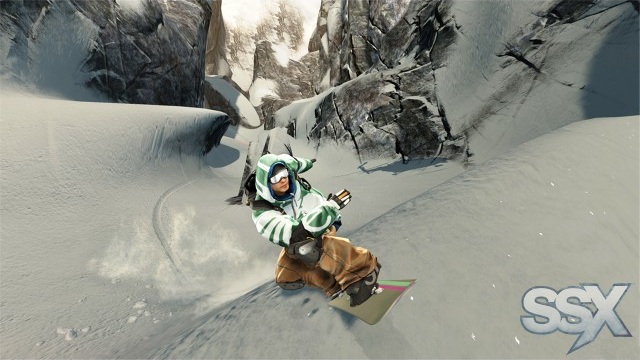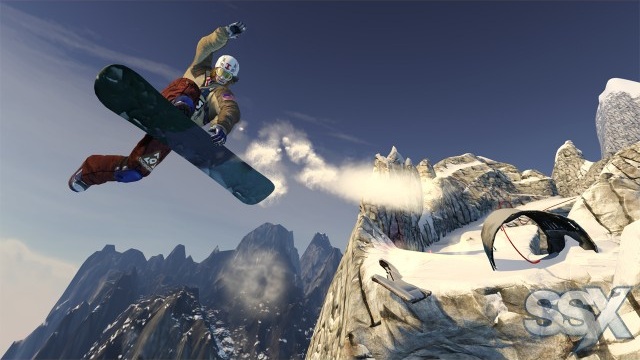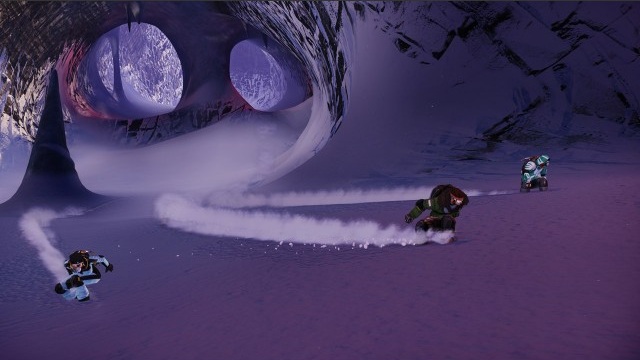To rock a rhyme, that's right on time.
At a press event a few months ago, a fellow reviewer pondered whether gamers were ready for another SSX. Being a fan who jumped and spun his way (Go, Kaori!) through the original three SSX titles for PS2 to full completion, I was startled at the question. Perhaps the slew of Wii installments has indeed numbed its audience and maybe snowboarding video games just aren't relevant anymore. At the same time, the box for SSX claims that it's one of the most anticipated games this year. Both are true, as conflicting as that might sound. But whichever way you feel, there's no need to worry. This SSX reboot does enough to push you out of the helicopter and onto the slopes once more.
SSX has always been fresh, and now it's even fresher… at least when it comes to the snow. Instead of the "funky fresh" that the series is known for, this reboot aims for a "mountain fresh" look by incorporating realistic physics and geographical data of real-world mountain ranges. It's a commendable approach, though it sometimes runs counter to the franchise's pillar of arcade slickness. That's just what happens when you try to stick reality into a game that's about jumping off a cliff, twisting in the air for seven rotations of Misty Stiffy, and landing without a hint of permanent knee damage.
Whether you choose to face the SSX Team's rival Griff in story mode, collect medals in event mode, or compete in global multiplayer events, you are challenged to conquer nine deadly descents, each with their own specific danger—the thin air of Mount Everest, the darkness of cavernous tunnels, the rolling prowl of an avalanche, the depth of bottomless pits. As such, you'll need to master the use of various life-saving gadgets, such as a headlight, an oxygen tank, a wingsuit, a solar panel, ice picks, and armor against trees and rocks.
There are plenty of normal challenges where you must race down a hill or earn a high score wth tricks, so these deadly descents add a welcome amount of variety to the fold. The majority of the new gadgets are integrated well with the new survival event type, with the exception of a few control oddities, like the touchy handling of the wingsuit or the reverse camera for the avalanche challenges.
As you continue to complete events and earn credits, your chosen character will earn experience points toward access to better gear and equipment. Gadgets with enhanced stats become available, along with faster boards with better boost and trick capabilities as well as a full array of temporary mods. You can even purchase Geotags, which you can leave almost anywhere on a course and grants you extra experience points if no one online manages to grab it.
Nonetheless, the game shines the brightest in the place where nostalgic SSX goodness comes through the most—wide open spaces that have an obscene amount of hills with orange arrows, red and twisty grinding rails, and branching lines that open countless possibilities down the slope. The snowflakes may have turned into collectibles instead of score multipliers and the course may not be as colorful as before, but the thrill of connecting one ridiculous move after another and hoping not to make a mistake before the finish line is still intact. The same goes for the awesome and completely customizable soundtrack, which even gets remixed when you're performing tricks. (I turned off all the dubstep, though.)

Ground tricks can now connect moves together, and gaining boost through performing tricks can now lead to two tiers of "tricky" maneuvers that turn regular moves into score-building powerhouses. Entering these "tricky" states is important not only for score contests, but also for races since they give you a limited amount of infinite boost.
However, one point of realism that the designers clearly struggled with are pits. It makes sense to include pits as a natural part of real-life deadly descents, but they can lead to plenty of needless frustration. It's the sole reason why they've included the new rewind function; at the cost of some points and a lot of time lost, escaping a pit is a simple matter of rewinding back to a safer spot.
While falling into a pit that's large and clearly in view is mainly your fault, there are far too many pits that are small, thin, or hidden in the dark. Unless you slow down to a crawl—but how fun is that?—you sometimes can't see what the hell is front of you until you've collided with it. More difficult courses have you winding through dark caverns with a headlight, craggy ice tunnels, or even the circular tops of icebergs. Here, pits can be too well hidden due to the angle of the camera, the high lip of a jump, some snow or fog that obscures the pit, or a combination of all three.
No matter what you do, the likelihood that you'll fall to your doom on these particular courses is frustratingly high, especially since many of them allow only a limited number of rewinds. You'll jump fantastically into the air, concentrate on twirling, realize two seconds too late that you're about to land in a gorge, and rewind to a point where you think you're safe… only to watch yourself plummet into the gorge again and rewind even further back. It's a cruel sequence of events that's especially annoying for races against AI opponents who just don't make mistakes. With some tenacity, luck, and an unhealthy amount of restarts, you'll manage to conquer these challenging courses, but you'll never want to do them again.

Compounding this is the somewhat loose controls, which are a tad sensitive when it comes to turning. The vast majority of courses have gigantic lanes and fields, so this isn't a problem that occurs often. Maneuvering immediately around corners to nail a particular line or jump is certainly not a bad thing. But for courses with a severe number of pits, trees, and rocks, all laid out in ways just to spite you, the combination of the loose controls and pitfalls will likely make you feel you have no control over your line. In other words, Death Zone can go die in a fire.
Perhaps the only consolation for this is that everyone is in the same boat. If you're going to die in a dark hole somewhere on a mountain, you might as well die along with your fellow online rivals. Global events challenge all SSX players to one up each other for glory and a whole lot of credits. The higher you rank on the leaderboard once the time expires, maybe after an hour or even a week, the more of the total pot you earn. Some drops require a large fee of credits just to participate, but those are usually for expert players who don't mind slaving away at a course for hours on end.
Ridernet elevates this competition further by allowing you to receive notices of any race times and high scores that your rivals have posted. If you're the type of player who's fueled by this kind of friendly nudging match, Ridernet will more than satisfy your needs. (In fact, call Anthony. He's like that.)
Despite some rough patches in difficulty, SSX manages to modernize itself with realism, course variety, and seamlessly integrated multiplayer. Even with the courses littered with pits and darkness, they can either be avoided or faced head-on with the same intensity as an epic boss battle. it doesn't have as bold of a personality than before, but ready or not, SSX is here to stay.
-
A solid comeback
-
Gadgets and deadly descents add variety
-
Realism
-
...to a fault with pits and darkness
-
Fantastic global multiplayer and Ridernet
-
Strong customizable soundtrack
-
Loose controls
-
Not as much flavor as prior SSX titles







